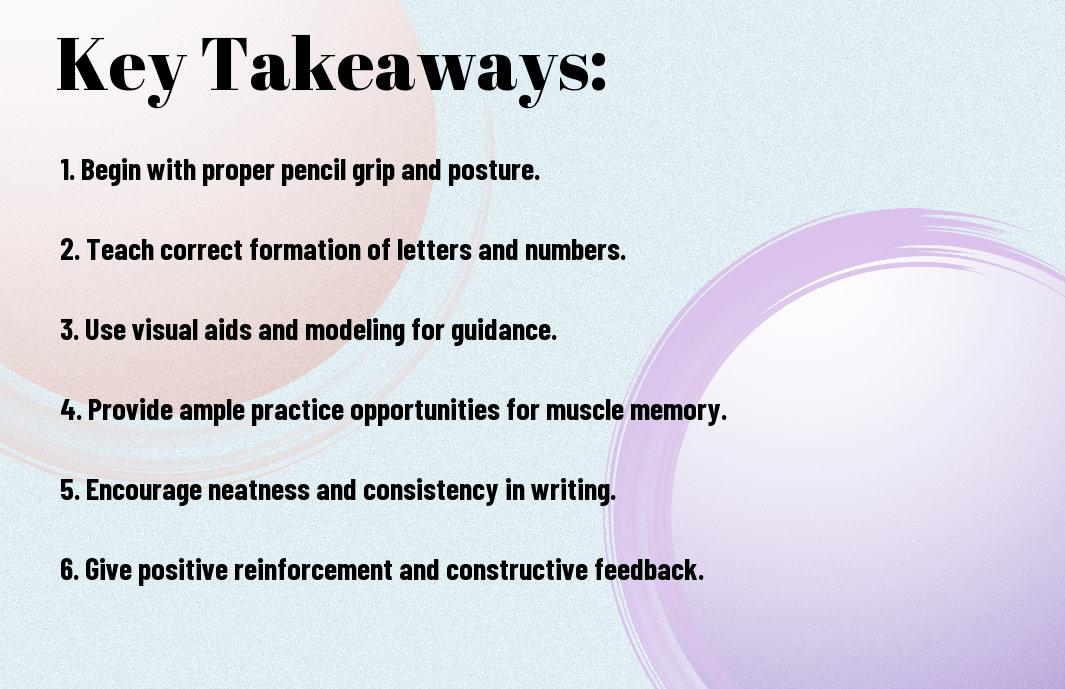Improving Handwriting in Kindergarten – A Step-by-Step Guide

Are you struggling to help your kindergartner improve their handwriting skills? Don’t worry, you’re not alone. Many parents and educators find it challenging to teach young children the fundamentals of handwriting. However, with the right approach and consistent practice, you can dramatically improve your child’s handwriting abilities. In this step-by-step guide, I’m going to walk you through some effective strategies and activities that will help your kindergartner develop better handwriting.
First and foremost, it’s important to understand that improving handwriting skills in kindergarten is a gradual process. It requires patience and persistence. By consistently incorporating specific handwriting exercises into your child’s daily routine, you can help them build the foundation for clear, legible handwriting. Additionally, making handwriting practice fun and engaging can motivate your child to put in the effort and improve their skills. Follow the steps and tips outlined in this guide, and you’ll soon see a noticeable difference in your kindergartner’s handwriting abilities.
Key Takeaways:
- Consistent Practice: Regular and consistent practice is essential for improving handwriting skills in kindergarten students.
- Proper Grip: Teaching children the correct pencil grip from the beginning can greatly improve their handwriting in the long run.
- Letter Formation: Focusing on proper letter formation and stroke order helps lay a strong foundation for handwriting development.
- Patience and Encouragement: Kindergarten teachers and parents should be patient and providing positive reinforcement to help children develop confidence in their handwriting abilities.
- Utilize Tools: Using tools such as lined paper, pencil grips, and pre-writing activities can aid in improving handwriting skills for kindergarten students.
Developmental Milestones for Handwriting
Obviously, handwriting development in kindergarteners is a gradual process that is influenced by a variety of developmental milestones. These milestones can be categorized into cognitive skills and fine motor skills, both of which play a crucial role in the development of handwriting abilities.
Cognitive Skills and their Role in Writing
As a kindergartener, your cognitive skills, such as attention, memory, and language abilities, are still developing. These skills play a crucial role in handwriting as they help you understand and interpret letters and words, remember how to form letters, and express your thoughts through writing. It’s important to foster these skills through activities that encourage focus, memory recall, and language development to support handwriting improvement.
Fine Motor Skills in Kindergarteners
Your fine motor skills, including hand-eye coordination, finger dexterity, and hand strength, are instrumental in the development of handwriting. Kindergarteners need to have strong and agile fingers to control writing utensils and make precise movements for letter formation. Engaging in activities that promote fine motor skills, such as drawing, coloring, cutting, and playing with manipulative materials, can help strengthen these skills and improve handwriting abilities.
Pre-Writing Skills
Some children may enter kindergarten without having developed the pre-writing skills necessary for successful handwriting. These skills include basic shapes and lines, as well as fine motor coordination. It is important to work on these skills before expecting children to master handwriting.
Basic Shapes and Lines
Introducing children to basic shapes and lines is a great way to prepare them for handwriting. By drawing and tracing shapes such as circles, squares, and triangles, children can begin to understand the different movements required for forming letters. Practice drawing straight lines, curved lines, and diagonal lines to further develop hand-eye coordination.
Strengthening Fine Motor Coordination
Strengthening fine motor coordination is essential for developing the hand muscles needed for handwriting. Activities such as cutting with scissors, using tweezers to pick up small objects, and threading beads onto a string can help improve fine motor skills. By incorporating these activities into playtime and classroom exercises, you can help your child develop the necessary coordination for successful handwriting.
By focusing on pre-writing skills and implementing activities to strengthen fine motor coordination, you can set your kindergarten-aged child up for success in developing good handwriting. These foundational skills are crucial for your child’s future academic endeavors and overall handwriting abilities.
Establishing a Handwriting-Friendly Environment
Your kindergarten classroom should be a place where students feel comfortable and supported as they learn and practice their handwriting skills. Creating a handwriting-friendly environment is key to helping your students develop strong penmanship. To create this environment, you can start by breaking down the handwriting process into manageable steps. One resource that can help you with this is Breaking It Down – How to Teach Handwriting in Kindergarten, which provides practical tips and ideas for teaching handwriting in a developmentally appropriate way.
Creating a Conducive Learning Space
When it comes to creating a conducive learning space for handwriting practice, it’s important to consider the layout of your classroom. Are there designated areas where students can sit comfortably and focus on their handwriting? Do you have a writing center that is stocked with a variety of writing tools and materials? By setting up a specific space for handwriting practice, you can create a quiet and focused environment that encourages students to concentrate on improving their penmanship. It’s also important to consider the lighting in the classroom, as well as the seating arrangements, to ensure that students can sit comfortably and with proper posture while practicing their handwriting.
Selecting the Right Tools and Materials
Choosing the right tools and materials for handwriting practice is crucial in helping students develop good handwriting habits. Pencils with the appropriate grip can help young students maintain a proper hold and prevent hand fatigue. You may also want to consider offering different types of paper, such as lined paper and blank paper, to help students practice different writing styles. Additionally, erasers and pencil grips can help students correct mistakes and improve their pencil grip. Providing a variety of writing tools and materials can help keep students engaged and motivated to practice their handwriting skills.
Teaching Techniques for Handwriting Improvement
Lastly, let’s dive into some effective teaching techniques that can significantly improve handwriting in kindergarten students. As a teacher, it’s important to implement structured teaching strategies, incorporate fun and play into learning, and individualize the learning experience for every child.
Structured Teaching Strategies
When it comes to improving handwriting, structured teaching strategies play a crucial role. By providing clear instructions and demonstrations, you can help your students understand the fundamentals of writing. Utilizing guided practice and repetitive exercises will also help them reinforce their handwriting skills. Moreover, setting achievable goals and providing feedback can motivate students to make continuous progress in their handwriting.
Incorporating Fun and Play into Learning
To make handwriting improvement an enjoyable experience for your students, it’s essential to incorporate fun and play into learning. Engaging in activities such as tracing letters in sand or shaving cream, using colorful markers or pens, and playing games that involve writing can make the learning process more exciting. By doing so, you can keep your students motivated and eager to practice their handwriting skills.
Individualizing the Learning Experience for Every Child
Every child has unique learning needs and handwriting abilities. Therefore, it’s important to individualize the learning experience for each student. By identifying their strengths and weaknesses in handwriting, you can tailor your teaching approach to address their specific challenges and build on their strengths. Providing personalized guidance and encouragement can make a significant difference in their handwriting development.
By implementing these effective teaching techniques, you can create a supportive learning environment that fosters improved handwriting skills in your kindergarten students. So, are you ready to apply these strategies in your classroom and witness the positive impact on your students’ handwriting?

Engaging Parents and Caregivers
Despite the fact that handwriting skills are typically taught in the classroom, it is crucial for parents and caregivers to play an active role in supporting and reinforcing these skills at home. Your involvement in your child’s handwriting development not only strengthens their abilities but also shows them that you value their education. So, how can you engage with your youngster to ensure their progress?
Tools for At-Home Handwriting Practice
Equipping your home with the right tools can make a significant impact on your child’s handwriting progress. Consider investing in writing materials that are suitable for their little hands, such as chunky pencils, crayons, and markers. Additionally, letter tracing activities, lined paper, and whiteboards can be valuable resources for practice. These tools not only make learning fun but also help your child develop essential motor skills required for handwriting.
Effective Communication Strategies for Reinforcement
When it comes to reinforcing handwriting skills at home, effective communication with your child is key. Encourage regular conversations about the importance of good handwriting and how it plays a role in their everyday life. Additionally, creating a positive and supportive environment where your child feels comfortable practicing their handwriting can significantly impact their progress. Whether it’s praising their efforts or offering constructive feedback, your words hold immense power in motivating your child to improve their handwriting.
As a parent or caregiver, your involvement in your child’s handwriting journey can make a world of difference. By providing the right tools and effective communication strategies, you can ensure a positive and supportive environment for your child to develop strong handwriting skills. Your engagement and support are crucial in reinforcing the skills learned in the classroom and empowering your child to excel in their handwriting journey.
Overcoming Common Handwriting Challenges
Now that you’ve learned the basics of improving handwriting in kindergarten, it’s time to address some common challenges that may arise. By understanding these challenges and learning how to overcome them, you can help your child develop strong and confident handwriting skills.
Addressing Reversals and Inconsistencies
If your child is struggling with reversals and inconsistencies in their letters and numbers, there are several strategies you can use to help them overcome these challenges. One effective approach is to use visual aids, such as highlighting the correct direction for forming letters or providing them with lined paper to help guide their writing. Additionally, practicing activities that focus on directional concepts, such as drawing shapes and patterns, can also be beneficial in improving their understanding of letter and number formation.
Dealing with Handwriting Speed and Legibility Issues
If your child is struggling with handwriting speed and legibility, it’s important to address this challenge early on to prevent frustration and discourage them from writing. Encouraging them to use proper posture and grip, as well as providing them with regular opportunities to practice writing, can help improve their speed and legibility. Additionally, consider implementing fun activities, such as tracing letters and copying short sentences, to help them develop the necessary skills for writing quickly and clearly.
By addressing these common handwriting challenges in kindergarten, you can set your child up for success in their academic and personal life. Remember, patience and practice are key in overcoming these obstacles. By implementing these strategies and providing consistent support, you can help your child build confidence and improve their handwriting skills.
Assessing Handwriting Progress
After implementing strategies to improve handwriting in kindergarten, it is important to assess the progress your students have made. Assessing handwriting progress allows you to identify areas for improvement and track the effectiveness of your teaching methods. This will help you tailor your instructional approach to meet the needs of each student and ensure they are developing the necessary skills for successful handwriting.
Setting Benchmarks and Goals
When assessing handwriting progress, it is helpful to set benchmarks and goals for your students. Consider the handwriting skills that are developmentally appropriate for kindergarten students and establish clear, measurable objectives for them to achieve. By setting benchmarks and goals, you can track the progress of each student and provide targeted support to help them reach their full potential.
Using Assessment to Guide Further Instruction
Assessment of handwriting progress should not just be a one-time activity, but an ongoing process that informs your teaching. By analyzing the assessment data, you can identify patterns and trends in your students’ handwriting abilities and use this information to guide your further instruction. If certain students are struggling with specific letter formations, spacing, or sizing, you can provide targeted practice activities to address these areas. This personalized approach ensures that each student receives the support they need to improve their handwriting skills.

Conclusion
Now that you have gone through this step-by-step guide for improving handwriting in kindergarten, you have the tools and knowledge to help your students or children develop strong foundational writing skills. By focusing on proper pencil grip, letter formation, and consistent practice, you can set the stage for a lifetime of successful handwriting. Remember to be patient and encouraging, as children may need time to develop their fine motor skills and master the techniques outlined in this guide. With your guidance and support, you can help kindergarten students build the confidence and ability they need to excel in their handwriting.
FAQ
Q: Why is it important to improve handwriting in kindergarten?
A: Improving handwriting in kindergarten is important because it lays the foundation for future academic success. Clear and legible handwriting is an essential skill that students will use throughout their school years and beyond.
Q: What are some effective strategies for improving handwriting in kindergarten?
A: Some effective strategies for improving handwriting in kindergarten include practicing proper pencil grip, using lined paper to help with letter sizing and spacing, and engaging in fine motor skill activities such as coloring, cutting, and tracing. Consistent practice and positive reinforcement are also key components in improving handwriting.
Q: How can parents and teachers help kindergarten students improve their handwriting?
A: Parents and teachers can help kindergarten students improve their handwriting by providing opportunities for regular practice, offering constructive feedback, and creating a supportive environment. It is important to be patient and encouraging, as developing handwriting skills takes time and effort. Additionally, incorporating fun and engaging activities into handwriting practice can help keep students motivated and enthusiastic about improving their skills.